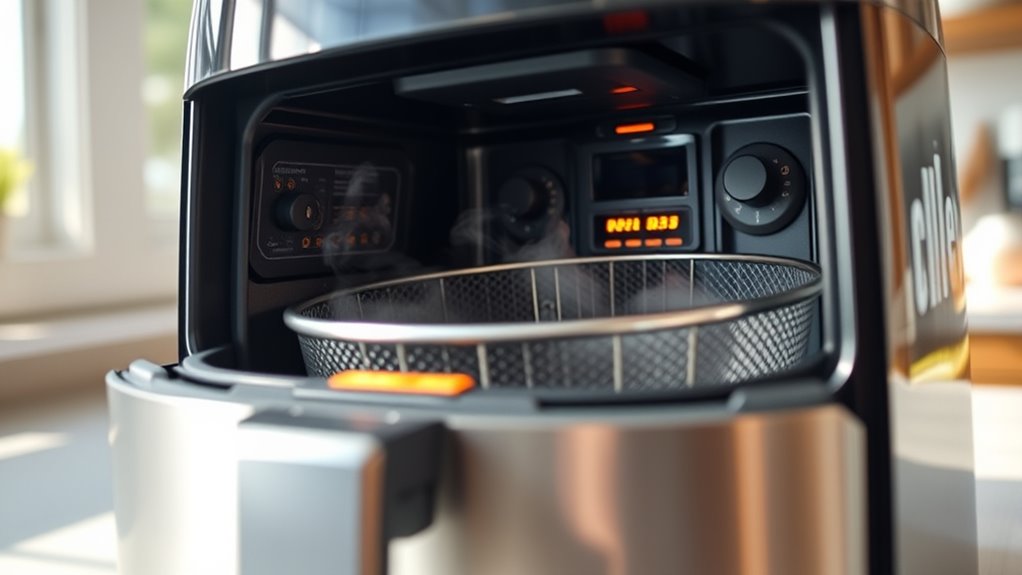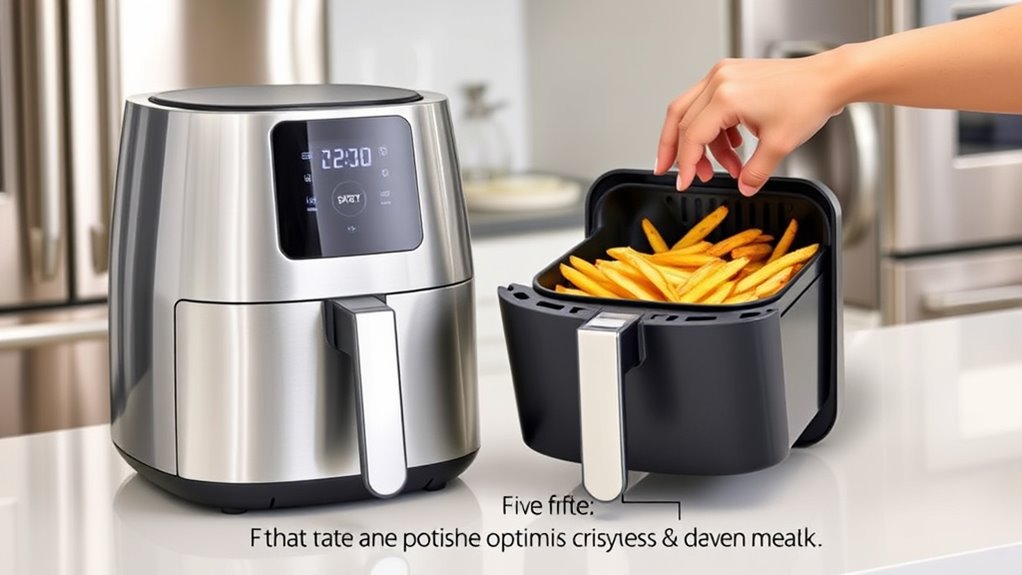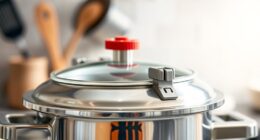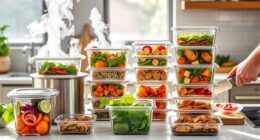Preheating your air fryer helps it reach the ideal temperature before cooking, ensuring your food cooks evenly and develops a crispy texture. It also improves safety by reducing risks of burning or uneven heating. By starting with a preheated appliance, you save time and achieve better results overall. If you want to learn more about how and when to preheat your air fryer for perfect meals, keep exploring the benefits and tips next.
Key Takeaways
- Preheat your air fryer before cooking to ensure it reaches the optimal temperature for even and efficient cooking.
- Preheating helps achieve crispy textures and tender interiors by distributing heat uniformly.
- It reduces cooking time and improves food safety by maintaining proper temperature levels throughout the process.
- Most recipes or appliance manuals recommend preheating to optimize results and prevent food from sticking or burning.
- Modern air fryers often include preheat features to enhance performance and ensure consistent cooking outcomes.

Preheating your air fryer can considerably improve the results of your cooking by ensuring the appliance reaches the ideal temperature before you start. This step might seem optional, but it plays a critical role in achieving perfectly cooked meals. When you preheat, you’re giving your air fryer a head start, allowing it to reach the right cooking temperature faster and more evenly. This consistency is especially important if you’re aiming for crispy textures or tender interiors. Without preheating, your food might cook unevenly, leading to overcooked edges and undercooked centers. Proper temperature management during preheating helps you control the cooking process more precisely.
Preheating ensures even cooking and better results every time.
In terms of air fryer safety, preheating is also a prudent practice. It minimizes the risk of food sticking to the basket or burning due to uneven heat distribution. When the air fryer is already at the right temperature, you avoid the temptation to leave food in longer than necessary, which can sometimes cause smoke or other safety hazards. Plus, many modern air fryers are equipped with safety features that activate when the appliance gets too hot or if there’s an issue with temperature regulation. Preheating helps you stay within safe cooking parameters, reducing the chance of accidents.
Understanding the importance of cooking temperature is essential for successful air frying. Preheating ensures that the appliance hits the target temperature promptly, so your recipes turn out just right. It’s also worth noting that different foods require different cooking temperatures, and starting with a preheated air fryer helps you manage these variations more effectively. For example, delicate items like fish fillets need a gentle, consistent heat, while crispy chicken wings benefit from an initial blast of high heat. When you preheat, you create an ideal environment that facilitates precise temperature control, leading to better results.
In addition, preheating can cut down on cooking time. When your air fryer is already at the right temperature, your food cooks faster and more evenly, saving you time and energy. This is especially helpful if you’re preparing multiple batches or cooking for a crowd. It’s a simple step that can transform your air frying experience, making it more efficient and enjoyable. Remember, always check your air fryer’s manual for specific preheating instructions, as some models may have particular recommendations. Overall, incorporating preheating into your routine enhances air fryer safety, improves cooking temperature management, and ensures you get the best possible results from your meals.
Frequently Asked Questions
Does Preheating Reduce Cooking Time Significantly?
Preheating your air fryer does reduce cooking time by improving preheating efficiency. When you start with a hot oven, your food begins cooking immediately, which shortens overall cooking time. While the reduction isn’t huge for small or quick-cooking items, it can make a noticeable difference for larger or denser foods. So, preheating helps you save time and guarantees more even, consistent results.
Can I Preheat Without Using Any Oil?
You can definitely preheat your air fryer without using any oil; oil-free preheating is simple with dry preheat methods. Just set the temperature and let it run empty for a few minutes—no oil needed. Intriguingly, many recipes benefit from this approach, especially when you’re aiming for crispy results without added fats. It’s a quick, efficient way to prepare your air fryer, making your cooking healthier and more convenient.
How Long Should I Preheat for Different Foods?
For different foods, preheat your air fryer for about 3-5 minutes. Use food-specific timing: 3 minutes for small snacks like fries, 4-5 minutes for chicken or vegetables, and up to 5 minutes for thicker cuts or frozen items. Adjust based on your air fryer’s model and the recipe. Preheating duration helps make sure of even cooking and crispy results, so don’t skip this step for best outcomes.
Is Preheating Necessary for All Types of Air Fryers?
Think of your air fryer as a musical instrument needing tuning before the concert. Not all air fryer models require preheating, but doing so can enhance cooking benefits, especially for crispy textures. Many modern models heat quickly and may not need preheating for every dish, yet preheating benefits include even cooking and better browning. Check your model’s manual; preheating can be a valuable step for ideal results.
Does Preheating Improve Food Texture and Crispiness?
Preheating your air fryer definitely improves food texture and crispiness enhancement. When you preheat, the hot air circulates quickly around your food, creating a better Maillard reaction that results in a more appealing crunch. Without preheating, your food might turn out soggy or unevenly cooked. So, for that perfect crispy exterior and tender interior, always preheat your air fryer before adding your ingredients.
Conclusion
Preheating your air fryer guarantees your food cooks evenly and crisps up perfectly. For example, imagine you’re making crispy chicken wings—preheating helps achieve that golden, crunchy exterior without overcooking the inside. Skipping this step might leave your wings soggy or unevenly cooked. So, next time, just a few minutes of preheating can make a big difference, turning an ordinary meal into a restaurant-quality dish you’ll love.




